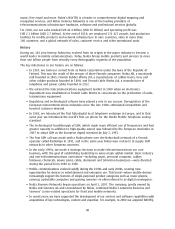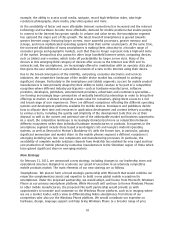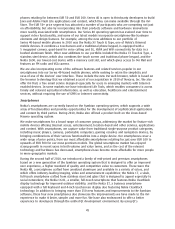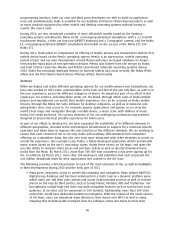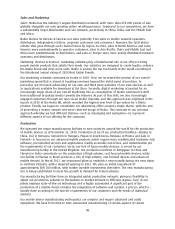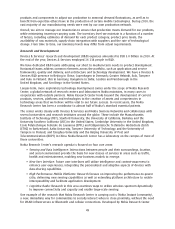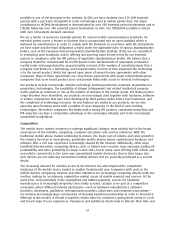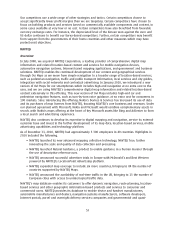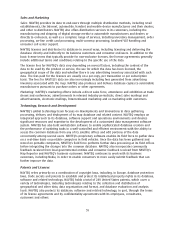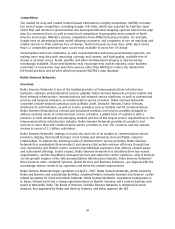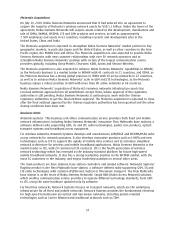Nokia 2010 Annual Report Download - page 50
Download and view the complete annual report
Please find page 50 of the 2010 Nokia annual report below. You can navigate through the pages in the report by either clicking on the pages listed below, or by using the keyword search tool below to find specific information within the annual report.products and components to adjust our production to seasonal demand fluctuations, as well as to
benefit from expertise others have in the production of certain mobile technologies. During 2010, the
vast majority of our manufacturing needs were met by our own production network.
Overall, we aim to manage our inventories to ensure that production meets demand for our products,
while minimizing inventorycarrying costs. The inventory level we maintain is a function of a number
of factors, including estimates of demand for each product category, product price levels, the
availability of raw materials, supplychain integration with suppliers and the rate of technological
change. From time to time, our inventory levels may differ from actual requirements.
Research and Development
Devices & Services’ research and development (R&D) expenses amounted to EUR 3.0 billion in 2010. At
the end of the year, Devices & Services employed 16 134 people in R&D.
We have dedicated R&D teams addressing our short to mediumterm needs in product development.
Horizontal teams address common elements across the portfolio, such as application and service
frameworks, quality and delivery, and architecture and technology development. We have a Devices &
Services R&D presence in Beijing in China; Copenhagen in Denmark; Greater Helsinki, Salo, Tampere
and Oulu in Finland; Ulm in Germany; Bangalore in India; London and Farnborough in the
United Kingdom; and San Diego in the United States.
Longerterm, more exploratory technology development comes under the scope of Nokia Research
Center, a global network of research centers and laboratories Nokia maintains, in many cases in
cooperation with outside partners. Nokia Research Center looks beyond the development of current
products, services, platforms and technologies to the creation of assets and competencies in
technology areas that we believe will be vital to our future success. In recent years, the Nokia
Research Center has been a contributor to almost half of Nokia’s standard essential patents.
The center works closely with Devices & Services and Nokia Siemens Networks and collaborates with
several universities and research institutes around the globe. These include the Massachusetts
Institute of Technology (MIT), Stanford University, the University of California, Berkeley and the
University Southern California (USC) in the United States; Cambridge University in the United Kingdom;
Ecole Polytechnique Federale de Lausanne (EPFL) and Eidgeno
¨ssische Technische Hochschule Zu
¨rich
(ETHZ) in Switzerland; Aalto University, Tampere University of Technology and the University of
Tampere in Finland; and Tsinghua University and the Beijing University of Post and
Telecommunication (BUPT) in China. Nokia Research Center has a laboratory on the campus of most of
these universities.
Nokia Research Center’s research agenda is focused on four core areas:
•
Sensing and Data Intelligence:
Interactions between people and their surroundings, location,
and social environment provide the basis for new classes of services in areas such as traffic,
health and entertainment, enabling new business models to emerge.
•
New User Interface:
Future user interfaces will utilize intelligence and contextawareness to
enhance user experiences, integrating the personalized and adaptive aspects of devices with
datasharing capabilities.
•
High Performance Mobile Platforms:
Research focuses on improving the performancetopower
ratio, delivering new sensing capabilities as well as extending platform architecture to enable
interoperability and facilitate application development.
•
Cognitive Radio:
Research in this area examines ways to utilize wireless spectrum dynamically
to improve connectivity and capacity and enable largescale sensing.
One example of the research that Nokia Research Center is carrying out is ’Nokia Instant Community’,
a new, immediate way for communities to socially interact when in close proximity, without the need
for WLAN infrastructure or Bluetooth and cellular connections. Developed by Nokia Research Center
49



